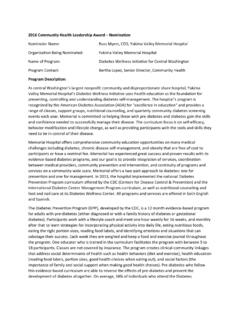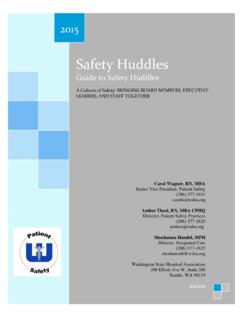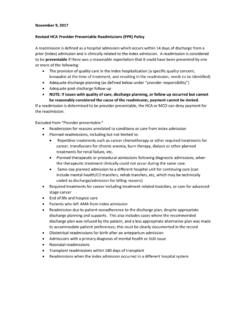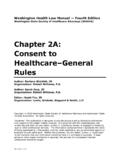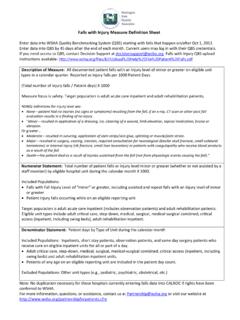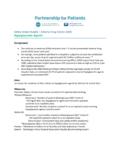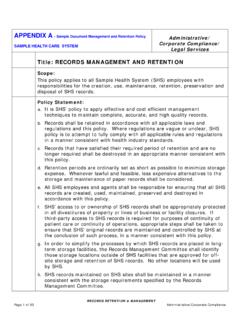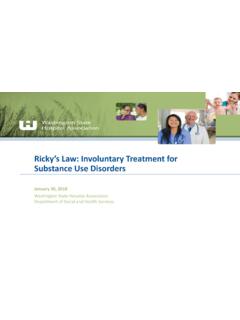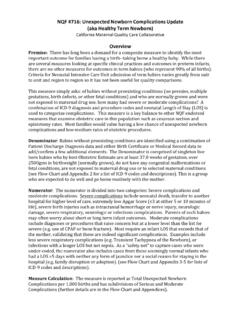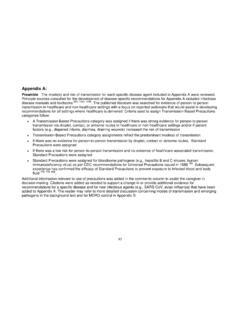Transcription of Guidance on Service Animals in Washington State Hospitals
1 Guidance on Service Animals in Washington State Hospitals June 2018 2 June 2018 Table of Contents I. CONTEXT & ISSUE ..3 II. SUMMARY ..3 III. A NOTE ON COMPLIANCE WITH BOTH FEDERAL AND State LAWS ..4 IV. DISCUSSION ..5 Overview ..5 1. Definition of Service Animal ..6 i. Limitation on Qualified Species: Dogs and Miniature Horses Only .. 6 ii. Qualification Limitation: Training Specific to the Individual s Disability .. 8 iii. No Limitation on Appearance or Proof of Status .. 9 iv. Miniature 9 v. Summary .. 9 2. Appropriate Inquiries: determining Whether an Animal is a Service Animal .. 10 3. Excluding a Service Animal from the hospital .. 12 i. A Service Animal Must Be Under Control .. 12 ii.
2 A Service Animal Must Not Present an Immediate or Reasonably Foreseeable Risk to Property or People .. 13 iii. A Service Animal is Generally Permitted Wherever the Public is Allowed to Go, But May Be Excluded from Limited-Access Areas Requiring Sterility and Infection Control .. 13 iv. Custody of Service Animal in the Event of Exclusion .. 14 v. Permissible and Impermissible Costs .. 14 4. Misrepresentation of an Animal as a Service Animal: Civil Infraction .. 14 i. Authority of an Enforcement Officer to Investigate and Enforce the Misrepresentation of Service Animals .. 15 ii. Refusal to Answer Enforcement Officer Inquiries Creates a Presumption that the Animal is Not a Service Animal.
3 15 APPENDIX A: DRAFT MODEL POLICY .. 16 1. Application .. 16 2. 16 3. Definitions .. 16 4. Uses and Restrictions of Service Animals in hospital .. 18 1. Rights and Responsibilities of the Service Animal 18 2. Rights and Responsibilities of hospital workforce , Including Health Care Providers ( hospital ) ..19 5. Permissible and Impermissible Inquiries .. 21 6. Misrepresentation of an Animal as a Service Animal .. 22 7. Legal Authority, Resources and Communication .. 22 I. CONTEXT & ISSUE Washington Hospitals face an increasing presence of pets on their premises. A growing number of patients, whether operating under sincere mistake or fraudulently, bring their Animals to Hospitals with them as though the Animals are Service Animals a protected class under Service animal laws (defined below) that are entitled to accompany individuals with disabilities wherever they go in order to assist them with managing their disabilities.
4 State and federal Service animal laws seek to uphold the dignity and respect of individuals living with disabilities who rely on these special Animals for crucial support. Practically speaking, however, confusion abounds. Members of a hospital workforce worry about offending or violating the law by making inquiries into the nature of an animal s role in the patient s life, or otherwise improperly restricting hospital access to the patient when there may be good reason to do so, such as hygienic, health and/or safety reasons. As a result, members of a hospital workforce may defer to the patient, or they may improperly exclude the animal (and the patient), believing they are acting as required by law. In short, the interpretation of these laws can hamper a hospital s ability to discern a true Service animal from a pet.
5 WSHA has been asked whether and to what extent Hospitals can inquire into the validity of a Service animal and to what extent the presence of a Service animal can be controlled. This information is provided as a courtesy to our members and includes information of State and federal law. Local counties and cities may have additional applicable laws. Legal counsel should be consulted for specific advice. II. SUMMARY Ed. note: the following applies to members of the public, including patients, visitors and vendors, but does not include members of the hospital workforce . Hospitals may inquire into whether an animal accompanying a person on hospital premises is a Service animal. Hospitals may ask two questions to help discern a Service Animal from a pet: 1.
6 Is the animal required because of a disability? 2. What work or task has the animal been trained to perform? Although the term Service animal implies that any animal may qualify, the only species that meet the legal definition are dogs and miniature horses. All other species of Animals , such as cats, reptiles, birds and rodents are excluded from the statutory definition of a Service animal and may be removed from a hospital s premises. As to dogs and miniature horses, the animal must be trained to perform work or a task directly related to the individual s (hereinafter referred to as Handler ) disability. The above inquiries may assist in identifying this qualifying characteristic; however, a hospital may not inquire into the nature of the Handler s disability.
7 Hospitals must take care not to do so. Even if an animal qualifies as a Service Animal, it may still be excluded from the premises under certain conditions. A Service Animal may be excluded if it is out of control, not housebroken, or presents an immediate or reasonably foreseeable risk of harm or injury to property or a person. A Service Animal may also be excluded from certain areas of the hospital if it is likely to undermine the general infection and sterility control measures in place, such as a burn unit or operating room. If an animal is excluded, 4 June 2018 its Handler must be given the opportunity to complete the purpose of his or her visit without the Service Animal present. A draft model policy governing the presence of Service Animals follows the discussion below at Appendix A.
8 III. A NOTE ON COMPLIANCE WITH BOTH FEDERAL AND State LAWS Federal and State laws provide individuals with disabilities the right to use a Service Animal in Hospitals . The following statutes and regulations, collectively referred to as Service animal laws, govern: Title III Regulations of the Americans with Disabilities Act ( ADA ) Chapter of the Revised Code of Washington ( RCW ) Chapter 162-26 of the Washington Administrative Code ( WAC ) (collectively with the RCW, the State laws ) Substitute House Bill 2822 (effective January 1, 2019) It does not appear as though the laws conflict with each other; however, it is important to consider how the State and federal schemes interact with each other and how to comply with both at the same time.
9 The federal Americans with Disabilities Act considers and addresses the issues associated with the use of Service Animals in far greater depth than the State laws. For the purposes of the draft model policy below, as well as the analysis of the application of the laws discussed above, WSHA has adopted the following principles of interpretation and Guidance : Where both federal and State laws discuss an issue: o WSHA adopts the interpretation that is most accommodating to the individual seeking to have an animal accompany him or her while on the hospital premises; and o WSHA identifies the commonality between the two schemes so that a hospital does not over-regulate itself or over-complicate its procedures.
10 Where only one of the schemes discusses an issue: o WSHA identifies the one scheme that sets out a requirement or consideration; and o WSHA treats that law and regulation as governing the entire sphere of the issue. When State laws are silent on an issue addressed by the ADA, such silence has been interpreted as federal law occupying that space. If a conflict exists between the two schemes and none has been identified to date WSHA would address the conflict on an issue-by-issue basis and consider any appropriate means of reconciling the two competing requirements . 5 June 2018 IV. DISCUSSION Overview Federal and State laws provide individuals with disabilities the right to use a Service animal in Hospitals .
